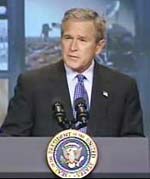
Image credit: Whitehouse.gov
As predicted for several months, US President George W. Bush announced his plan for the future human exploration of space. Bush was joined by NASA administrator Sean O’Keefe and the press briefing was introduced by the commander of Expedition 8, Michael Foale – currently aboard the International Space Station.
Under the new plan, the United States would complete its work on the International Space Station by 2010, which is being developed by 15 countries, and then retire the space shuttle fleet. In tandem with this, NASA will develop a new program of human space exploration which will eventually return humans to the Moon.
As predicted for several months, US President George W. Bush announced his plan for the future human exploration of space. Bush was joined by NASA administrator Sean O’Keefe and the press briefing was introduced by the commander of Expedition 8, Michael Foale – currently aboard the International Space Station.
Under the new plan, the United States would complete its work on the International Space Station by 2010, which is being developed by 15 countries, and then retire the space shuttle fleet. In tandem with this, NASA will develop a new program of human space exploration which will eventually return humans to the Moon.
The first robotic explorers would reach the Moon in 2008; human explorers would follow by 2015-2020. Although Bush was expected to announce a permanent lunar base, no details were given. Bush hinted, but didn’t provide any details about follow-on human missions to Mars.
The plans call for a new kind of spacecraft, called the Crew Exploration Vehicle; a general purpose spacecraft which would be capable of servicing the International Space Station and reaching locations beyond low-Earth orbit, such as the Moon, asteroids, and the Lagrange points (stable places in space which are balanced between the gravity of two objects, such as the Earth and Moon).
NASA has said that this new vehicle will be dramatically different from the Orbital Space Plane, which NASA was developing as a replacement spacecraft to travel to and from the International Space Station. NASA had originally intended to award contracts for the OSP in 2004, which would eventually cost $15 billion US.
In order to finance this new plan, the president will be asking Congress in February to provide NASA with an additional $1 billion US in 2005, spread out over five years. Additional funds for the program would come from reorganizing NASA’s existing projects, like retiring the space shuttle by the end of the decade.
Maintaining and launching the space shuttle costs approximately $4 billion a year and the International Space Station costs $1 billion a year. It’s not clear what effect winding down the shuttle will have on the thousands of workers and contractors employed by the program; although, Bush did say that it would be “with existing programs and personnel.”
Bush called this new initiative a “journey, not a race”, and encouraged international partners to join the United States in exploring the solar system with human beings.
He said that the next step will be the formation of a special commission to “explore the vision I have outlined today”. This commission, led by former Air Force Secretary Peter Aldridge, will deliver a report to President Bush within four months.
More background on the new space initiative is available here.
